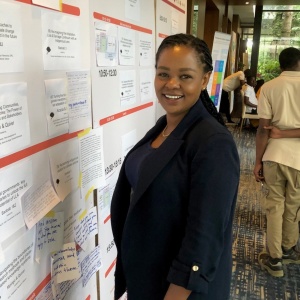Ritha Tarimo is regional director of Trias East Africa. She’s leading the project "CLEAR: Community-Led Environmental and Agricultural Restoration - strengthening locally led restoration capacity among farmer and pastoralist communities in the Southern Highlands and Northern (semi-) Arid areas of Tanzania".
What are the unsustainable agricultural and pastoral practices you are trying to change?
Ritha: There are several examples. In pastoral areas, overgrazing has become the norm. When the land is degraded, there is no food for the cattle. Then there’s cutting trees down to feed animals, and for timber for firewood and torches for protection against unwelcome wildlife.
Land is scarce because of people spreading to new areas after land has degraded. We had 100,000 cows dying of hunger in 2023. And this leads to a high level of human-wildlife conflict, causing problems for pastoralists and communities, and for the government. Good agricultural practices could avoid this.
But there are deeper problems that are not so visible. Land degradation combined with the impacts of climate change, increases mental health challenges such as depression and suicide. There’s loss of culture and a decline in trust between citizens. There are tensions between settled communities practising agriculture and pastoralists.
How do you guide community-led research?
Ritha: Trias alongside the communities, women, young people – everyone, has co-created a ‘building resilience tool’, a participatory method in which we discuss how the land used to be, how it is now, and we work together to consider how we could restore it, identifying challenges and solutions – all with communities. That must be the way, otherwise, solutions coming out of research won’t be sustainable, practical or realistic.
What kind of solutions are you envisioning?
Ritha: Restoration efforts might include reducing invasive plants, co-designing the use of land – areas for forests, for animal grazing, for tree planting – and maintaining it. And controlling floods and water management with the help of nature.
On tree restoration we might revive the plants using an ancient method called Kisiki hai (alive stem), creating trenches to control water supply.
And at times when drought goes on for months, we could use water harvesting to find ways to collect and store water. For example, taking it off the roads and creating channels for storage spots in the village.
Ultimately, the Community-led Environment and Restoration (CLEAR) programme wants to build the resilience skills of communities.
What kind of policies are you trying to influence? And which actors?
Ritha: I don’t want to pre-empt the project but at the national level, we want to influence how climate and resilience funds are used. We want the government to provide education and awareness, and to be honest with citizens about the devastating consequences of land degradation.
Governments and communities should take environmental damage, caused by actions - cutting down trees, for example, seriously. Investors – mostly international ones – are cutting down trees to create space for factories. We need by-laws at the district and regional levels.
CLEAR will implement grass seed banks led by women in pastoral and agricultural areas. They will plant seeds to provide their own fodder and for selling to pastoralists. This planting is also restoring the land – thousands of hectares so far.
How do you bring on board isolated farmers or young people or women, and engage them?
Ritha: Each community is different. We invite women, and other socially disadvantaged groups, to join activities; other places there are champions who can advocate for change – who make people feel it’s safe to join and to share opinions.
We do lots of awareness and education activities. We bring in religious leaders, local and traditional leaders and informed young people. People who have already benefited from the knowledge and who can speak up for the education and support.
We make sure that young people feel the value of their voices being heard. We equip them with business skills and encourage environmental businesses, finding markets for their produce - honey, for example.
We want everyone to understand that if we protect forests, we get financial benefits – and with more commitment, comes a greater income and greater independence.
What’s the one result you’d like to see from the project?
Ritha: I want to see restored land so that land is healthy, people have food security, and are included in taking care of their wellbeing and the community.
